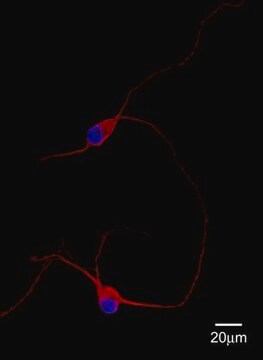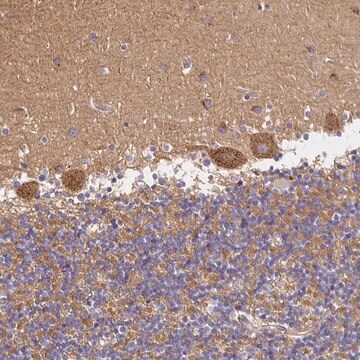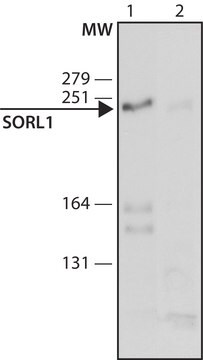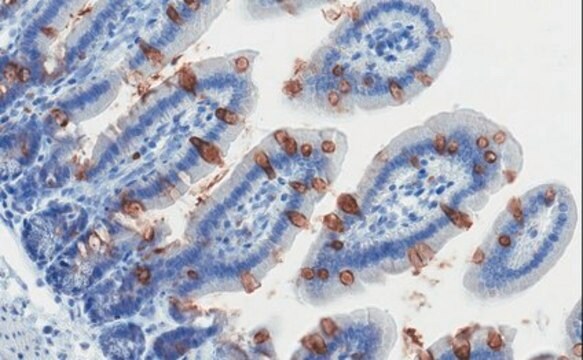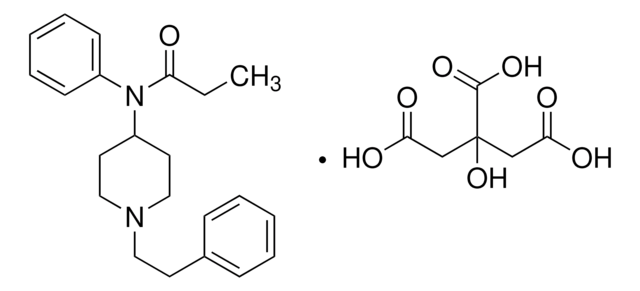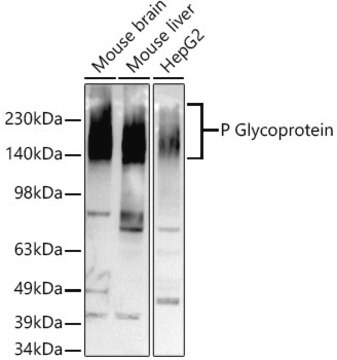MABN1793
Anti-SorLA Antibody, clone 20C11
clone 20C11, from mouse
Synonim(y):
Sortilin-related receptor, Gp250, LDLR relative with 11 ligand-binding repeats, Low-density lipoprotein receptor relative with 11 ligand-binding repeats, LR11, SorLA, SorLA-1, Sorting protein-related receptor containing LDLR class A repeats
About This Item
Polecane produkty
pochodzenie biologiczne
mouse
Poziom jakości
forma przeciwciała
purified immunoglobulin
rodzaj przeciwciała
primary antibodies
klon
20C11, monoclonal
reaktywność gatunkowa
mouse, human
metody
ELISA: suitable
immunocytochemistry: suitable
western blot: suitable
izotyp
IgG1κ
numer dostępu NCBI
numer dostępu UniProt
docelowa modyfikacja potranslacyjna
unmodified
informacje o genach
human ... SORL1(6653)
Opis ogólny
Specyficzność
Immunogen
Zastosowanie
Immunocytochemistry Analysis: A representative lot detected SorLA immunoreactivity primarily located at the cell body (soma) by fluorescent immunocytochemistry staining of 4% paraformaldehyde-fixed, 0.1% Triton X-100-permeabilized primary murine hippocampal neurons (Gustafsen, C., et al. (2013). J. Neurosci. 33(1):64-71).
Immunocytochemistry Analysis: A representative lot immunostained endocytic vesicular structures containing endocytosed sAPP by fluorescent immunocytochemistry staining of 4% paraformaldehyde-fixed, 0.1% Triton X-100-permeabilized HEK293 cells expressing exogenously transfected human SorLA (Gustafsen, C., et al. (2013). J. Neurosci. 33(1):64-71).
Immunocytochemistry Analysis: A representative lot detected the cellular localization of exogenously expressed wild-type and the FANSHY-to-6A4 mutant human SorLA by fluorescent immuncytochemistry staining of 4% paraformaldehyde-fixed, 0.5% saponin-permeabilized SH-SY5Y transfectants (Fjorback, A.W., et al. (2012). J. Neurosci. 32(4):1467-1480).
Western Blotting Analysis: A representative lot detected endogenous SorLA in sucrose gradient-fractionated mouse brain extracts as well as the expression of exogenously transfected human SorLA in HEK293 transfectants (Gustafsen, C., et al. (2013). J. Neurosci. 33(1):64-71).
ELISA Analysis: Representative lots were employed as the detection antibody for quantiating SorLA level in human brain cortical extracts as well as the level of exogenously expressed human SorLA in CHO cells (Caglayan, S., et al. (2012). Arch. Neurol. 69(3):373-379; Schmidt, V., et al. (2012). EMBO J. 31(1):187-200).
Jakość
Immunocytochemistry Analysis: 4.0 µg/mL of this antibody immunostained SorLA endocytic vesicles in HEK293 cells expressing transfected human SorLA.
Opis wartości docelowych
Postać fizyczna
Inne uwagi
Nie możesz znaleźć właściwego produktu?
Wypróbuj nasz Narzędzie selektora produktów.
Kod klasy składowania
12 - Non Combustible Liquids
Klasa zagrożenia wodnego (WGK)
WGK 1
Temperatura zapłonu (°F)
Not applicable
Temperatura zapłonu (°C)
Not applicable
Certyfikaty analizy (CoA)
Poszukaj Certyfikaty analizy (CoA), wpisując numer partii/serii produktów. Numery serii i partii można znaleźć na etykiecie produktu po słowach „seria” lub „partia”.
Masz już ten produkt?
Dokumenty związane z niedawno zakupionymi produktami zostały zamieszczone w Bibliotece dokumentów.
Nasz zespół naukowców ma doświadczenie we wszystkich obszarach badań, w tym w naukach przyrodniczych, materiałoznawstwie, syntezie chemicznej, chromatografii, analityce i wielu innych dziedzinach.
Skontaktuj się z zespołem ds. pomocy technicznej